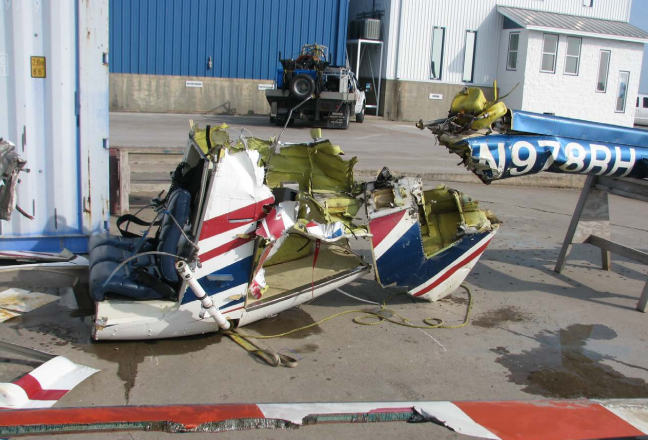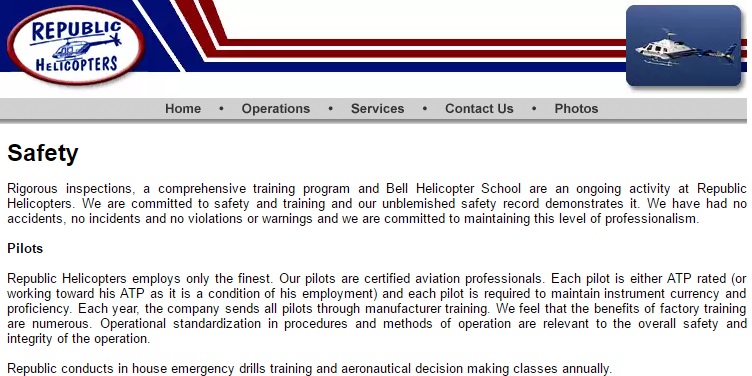Deadly Delay: GOM B206B3 Helicopter Night Accident 6 Feb 2017
The US National Transportation Safety Board (NTSB) has released preliminary information on a fatal accident involving Bell 206B N978RH of Republic Helicopters off the coast of Galveston Island, TX on 6 February 2017:
The flight originated from the oil tanker Eagle Vancouver, anchored in Galveston Bay…and was en route to Republic Helicopters heliport (2TE1), in Santa Fe [TX].
This was the helicopter’s third flight of the day. It departed 2TE1 at 1404 and flew to the oil tanker Eagle Vancouver and landed at 1457. The two passengers, both employees of Societe Generalde Surveillance (SGS) deplaned and commenced their work on the tanker.
Significantly:
The helicopter was scheduled to depart the tanker about 1600 but was delayed for unknown reasons. The helicopter eventually took off at 1837 and was scheduled to arrive at 2TE1 at 1910. Sunset was at 1802.
Hence, the return flight was at night and also breeched industry guidance to schedule landing 30 minutes prior to sundown.
The last radio communication from the pilot to Republic Operations was at 1906, when he reported he had the lights of Galveston in sight. The helicopter was equipped with a Blue Sky Global Positioning System (GPS) tracking system. The last data point from the Blue Sky system was at 1906…about .27 miles from the Galveston Island coastline. Altitude was 494 feet and speed was 127 mph. The accident site was…in West Bay, between Galveston Island and the mainland, or 4.30 miles from the last data…
Wreckage of Republic Helicopters Bell 206B N978RH Recovered off Galveston, TX after a Delay Collecting SGS Employees and Unintended Night Flight (Credit: NTSB)
One passenger was fatally injured. The pilot and a second passenger were seriously injured. The helicopter was destroyed.
Additionally, the NTSB say:
Instrument meteorological conditions (IMC) prevailed at the time of the accident.
The wreckage was recovered on February 8. Examination disclosed no evidence of airframe or flight control malfunction or failure. Engine examination disclosed no anomalies.
Despite one of its Bell 230s suffering a blade strike on the deck of a vessel in 2011, Republic still boasts of an accident free record (and that their pilot maintain instrument currency) on their website (as downloaded today):
A further fatal Gulf of Mexico helicopter accident occurred on 27 February 2017, involving Westwind Helicopters Bell 407 N1371 (see NTSB investigation).
See also: Helicopter Ops and Safety – Gulf Of Mexico 2015 Update
UPDATE 11 December 2017: The NTSB determined the probable cause as follows:
The pilot’s failure to recognize the flight had encountered instrument meteorological conditions at night, which resulted in an unrecognized descent and collision with water.
NTSB say:
The helicopter was equipped with a GPS SkyRouter fast tracking system that reports the helicopter’s position every 2 minutes. The last data point received from the GPS SkyRouter system was at 1906, when the helicopter was about 0.27miles from the Galveston Island coastline at 494 feet and 127 mph. Republic Helicopters An “Inactive” signal was received from the Blue Sky GPS by Republic Helicopters Operations 10 minutes after this last contact, or 1916, and the U.S. Coast Guard was alerted. Based on time and distance from the last data point to the accident location with an approximate helicopter speed of 120 mph, the time of the accident was computed to be 1909
…the moon was “Waxing Gibbous with 78% of the Moon’s visible disk illuminated. The moonlight would have likely been visible above the cloud tops. Below 3,000 feet near the accident site at the accident time would have been instrument meteorological conditions with no moonlight visible.” [Full weather report]
The helicopter was recovered from West Bay on February 8, 2017, by T&T Marine Salvage, Inc [who] reported the water depth at the accident site was approximately 7 to 8 feet, and all recovered wreckage was found in a radius of 80 to 100 feet.
Damage was consistent with a relatively level water impact. The fuselage was separated into several sections. The cabin and cockpit area was extensively damaged. The main rotor had departed the helicopter. There was evidence of mast bumping. The mast fracture was consistent with the rotating main rotor blades striking the water. Three main rotor blades strikes to the fuselage were noted
The pilot and right rear seat passenger were both seriously injured and were found by the U.S. Coast Guard approximately one hour after the accident, clinging to a section of fuselage.
The pilot had sustained stomach and intestinal trauma, several lumbar fractures, and abrasions on his shoulders, consistent with rubbing of the shoulder harness. The left front seat passenger was fatally injured and was found about 100 meters from the wreckage.
The company did express concern on “the lengthy time frame for the Coast Guard to respond once the organization had implemented the its missing aircraft procedure in accordance with their emergency response plan”. However, recoverer 1 hour after the accident is not bad at night.
In his NTSB interview the pilot explained:
..he did not recall any anything else until he realized he was submerged in water and was attempting to release himself from his safety belt; he indicated that it took more than one attempt to release the safety belt and then he went to the surface of the water.
He indicated that he was hanging onto the fuselage and was not sure how he had got there . When he surfaced he assumed he was in the bay and had crossed over the beach, as he could see lights on three sides. At that point, he recalls one of the passengers surfacing and joining him at the fuselage. He stated that he had inflated his life preserver and that he also inflated the life preserver of the passenger. He recalls telling the passenger to hang on to the fuselage, as there would be someone coming to get them. He noticed that the passenger was shivering and cold, so he moved closer to the passenger for body warmth, and kept engaging the passenger in conversation to keep both of them awake.
Eventually they noticed a searchlight on the surface of the water from an approaching boat, at which time they were rescued from the water and taken to the shore.
Republic Helicopter’s site no longer mentions safety.
Safety Resources
Although not mentioned in the NTSB report into the loss of this Bell 206, in 2013 the NTSB issued Safety Alert SA-020 Reduced Visual References Require Vigilance. They comment that:
Historically, about two-thirds of all general aviation (GA) accidents that occur in reduced-visibility weather conditions are fatal. These accidents typically involve pilot spatial disorientation or controlled flight into terrain.
Remote areas with limited ground lighting provide limited visual references cues for pilots, which can be disorienting or render rising terrain visually imperceptible.
We previously wrote: So You Think The GOM is Non-Hostile?
UPDATE 3 June 2017: Our 2016 GOM review.
UPDATE 3 September 2017: Night Offshore Training AS365N3 Accident in India
UPDATE 23 June 2018: Our 2017 GOM review.
UPDATE 2 November 2019: Taiwan NASC UH-60M Night Medevac Helicopter Take Off Accident
UPDATE 19 April 2020: SAR Helicopter Loss of Control at Night: ATSB Report
Aerossurance is pleased to sponsor the 2017 European Society of Air Safety Investigators (ESASI) 8th Regional Seminar in Ljubljana, Slovenia on 19 and 20 April 2017. Registration is just €100 per delegate. To register for the seminar please follow this link. ESASI is the European chapter of the International Society of Air Safety Investigators (ISASI).




Recent Comments